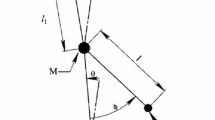Abstract
Power reduction in the ankle joints of a biped robot is considered inthis paper. Ankles of human beings have small torque and are veryflexible within a certain range of motion (very stiff near and beyondthis range). This characteristic makes foot landing soft and gives agood contact between its sole and the ground. This feature can beimplemented in a biped robot by using a small actuator for the anklejoints. A small actuator consumes less energy and reduces the weightof the leg. With less power in the ankle joints, robot walkingbecomes more difficult to control. This problem can be solved byproviding a feedback control mechanism as presented in this paper. Thecontrol mechanism uses the motion of the body and the swinging leg toeliminate instability caused by the weak ankle. Two locomotionexamples, standing and walking, were investigated respectively toshow the validity of the proposed control scheme. In standing, thecontrol input is the displacement of the ankle joint of thesupporting leg. The control mechanism decides the bending angle ofthe body and the position of the swinging leg. For walking, only thebending angle of the body is used to avoid the discontinuity of thecontrol input. Experimental results are presented to show theeffectiveness of the control mechanism.
Similar content being viewed by others
Explore related subjects
Discover the latest articles and news from researchers in related subjects, suggested using machine learning.References
Barin, K. 1989. Evaluation of a generalized model of human postural dynamics and control in the sagittal plane. Biol. Cybern., 61:37–50.
Dunn, E.R. and Howe, R.D. 1994. Towards smooth bipedal walking. Proc. 1994 IEEE Int. Conf. on Robotics and Automation, San Diego, CA, pp. 2489–2494.
Dunn, E.R. and Howe, R.D. 1996. Foot placement and velocity control in smooth bipedal walking. Proc. 1996 IEEE Int. Conf. on Robotics and Automation, Minneapolis, MN, pp. 578–583.
Furusho, J. and Sano, A. 1990. Sensor-based control of a nine-link biped. The Int. J. of Robotics Research, 9(2):83–98.
Hemami, H. and Wyman, B.F. 1979. Modeling and control of constrained dynamic systems with application to biped locomotion in the frontal plane. IEEE Trans. on Automatic Control, AC-24(4):526–535.
Hodgins, Jessica K. and Raibert, Marc H. 1991. Adjusting step length for rough terrain locomotion. IEEE Trans. on Robotics and Automoation, 7(3):289–298.
Jalics, L., Hemami, H., and Clymer, B. 1996. A control strategy for adaptive bipedal locomotion. Proc. 1996 IEEE Int. Conf. on Robotics and Automation, Minneapolis, MN, pp. 563–569.
Kajita, S. and Tani, K. 1991. Study of dynamic biped locomotion on rugged terrain. Proc. 1991 IEEE Int. Conf. of Robotics and Automation, Sacramento, CA, pp. 1405–1411.
Kajita, S., Yamaura, T., and Kobayashi, A. 1992. Dynamic walking control of a biped robot along a potential energy conserving orbit. IEEE Trans. on Robotics and Automation, 8(4):431–438.
Kajita, S. and Tani, K. 1996. Adaptive gait control of a biped robot based on realtime sensing of the ground profile. Proc. 1996 IEEE Int. Conf. on Robotics and Automation, Minneapolis, MN, pp. 570–577.
Katoh, R. and Mori, M. 1984. Control method of biped locomotion giving asymptotic stability of trajectory. Automatica, 20(4):405–414.
Kuo, Arthur D. and Zajac, Felix E. 1993. A biomechanical analysis of muscle strength as a limiting factor in standing posture. J. Biomechanics, 26(Suppl. 1):137–150.
Miura, H. and Shimoyama, I. 1984. Dynamic walk of a biped. Int. J. of Robotics Research, 3(2):60–74.
Mochon, Simon and McMahon, Thomas A. 1980. Ballistic walking. J. Biomechanics, 13:49–57.
Raibert, Marc H. et al. 1989. Dynamically stable legged locomotion. MIT Artificial Intelligence Lab., TR-1179, LL-6.
Siegler, Jie Chen S. and Schneck, Carson D. 1988. The three-dimensional kinematics and flexibility characteristics of the human ankle and subtalar joint-Part II: Flexibility characteristics. ASME J. Biomechanical Eng., 110:374–385.
Wagner, N., Mulder, M.C., and Hsu, M.S. 1988. A knowledge based control strategy for a biped. Proc. 1988 IEEE Int. Conf. on Robotics and Automation, Philadelphia, PA, pp. 1520–1524.
Zheng, Y.F. and Sias, F. 1988. Design and motion control of practical biped robots. Int. J. of Robotics and Automation, 3(2):70–78.
Zheng, Y.F. and Shen, J. 1990. Gait synthesis for the SD-2 biped robot to climb sloping surface. IEEE Trans. on Robotics and Automation, 6(1):86–96.
Author information
Authors and Affiliations
Rights and permissions
About this article
Cite this article
Yi, K.Y., Zheng, Y.F. Biped Locomotion by Reduced Ankle Power. Autonomous Robots 4, 307–314 (1997). https://doi.org/10.1023/A:1008800311277
Issue Date:
DOI: https://doi.org/10.1023/A:1008800311277




